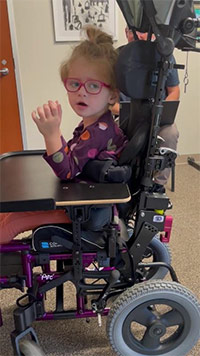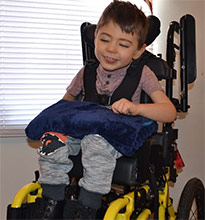Early Intervention: don’t wait for the break!
Michelle L. Lange, OTR/L, ATP/SMS
 I have spent the majority of my career working in pediatrics. Pediatric therapists are proactive in their approach – we are constantly attempting to meet a child’s current needs while also considering likely future needs. We anticipate problems and try to head these off.
I have spent the majority of my career working in pediatrics. Pediatric therapists are proactive in their approach – we are constantly attempting to meet a child’s current needs while also considering likely future needs. We anticipate problems and try to head these off.
How do you accurately anticipate future needs? I sure can’t predict the future; however, we have a great deal of evidence and experience which informs our decisions. For example, if a child has a progressive condition, we can look at the evidence to inform us of typical prognosis and course.
Let’s take a look at a child who is likely to need Dynamic Seating. This child may be demonstrating increased muscle tone, whole body extensor spasms, dystonia, and/or large and forceful movements. Or, this child may be seeking out movement, such as rocking.
So, when should I consider Dynamic Seating?
It is tempting to wait it out. To see if the child can maintain their posture, if an injury occurs, or if components are moving out of alignment or even breaking. Maybe we will order Dynamic Seating on the next wheelchair, if we think it is still needed…
Being proactive can head off these issues.
 If I am working with a child with a persistent posterior pelvic tilt, I am going to recommend seating interventions to keep that pelvis in neutral – perhaps an anti-thrust curb built into the cushion, adequate posterior pelvic support, and a 60 degree pelvic positioning belt. I don’t wait until I see changes in the spine, decreased sitting tolerance, and decreased functioning secondary to a chronically flexed trunk and head. The same proactive approach applies to Dynamic Seating.
If I am working with a child with a persistent posterior pelvic tilt, I am going to recommend seating interventions to keep that pelvis in neutral – perhaps an anti-thrust curb built into the cushion, adequate posterior pelvic support, and a 60 degree pelvic positioning belt. I don’t wait until I see changes in the spine, decreased sitting tolerance, and decreased functioning secondary to a chronically flexed trunk and head. The same proactive approach applies to Dynamic Seating.- If I am working with a child who is actively extending, I am going to recommend Dynamic Seating to provide movement in response to the child’s forces – diffusing those forces, maintaining client posture in relation to the seating support surfaces, and improving sitting tolerance, comfort, function, and alertness.
- If I am working with a child seeking out movement, such as rocking, I am going to recommend Dynamic Seating to allow movement without loss of position and with an increase in client alertness and engagement and a decrease in maladaptive behaviors.
Let’s be proactive with the young children we serve!
I’d love to hear your thoughts – please share below in the comments!
